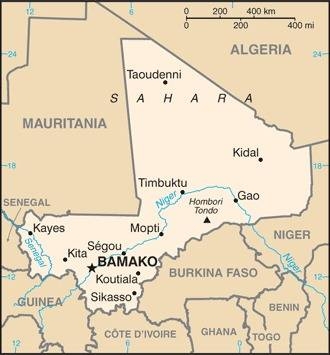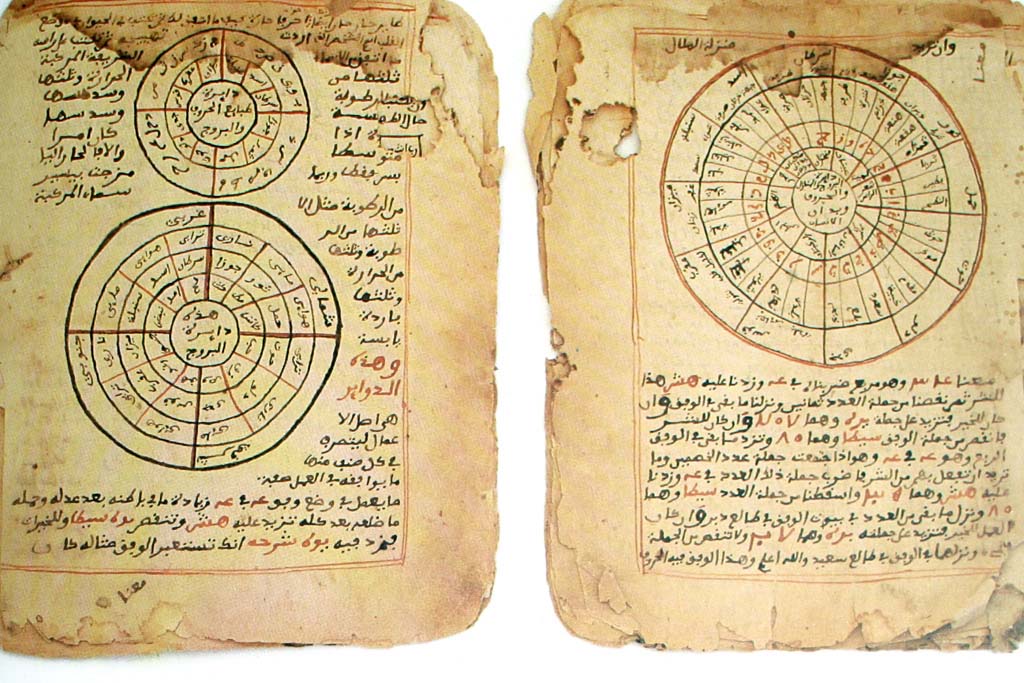208 Mali

Three equal vertical bands of green (hoist side), yellow, and red.
Flag courtesy of the CIA World Factbook

Map courtesy of the CIA World Factbook

The pages above are from Timbuktu Manuscripts written in Sudani script (a form of Arabic) from the Mali Empire showing established knowledge of astronomy and mathematics. Today there are close to a million of these manuscripts found in Timbuktu alone.
Government
According to Britannica, the constitution promulgated at independence in 1960 guaranteed parliamentary democracy, although the provisions of it were not fully implemented. It was suspended after a military government took power in 1968, and a new constitution, approved in a national referendum in 1974 and enacted in 1979, made the Malian People’s Democratic Union (Union Démocratique du Peuple Malien; UDPM) the country’s sole legal party until 1991. In 1992 a third constitution was approved, providing for the separation of powers into three government branches, including a unicameral National Assembly as the legislative body. It also guaranteed the right to multiparty politics. The members of the Assembly are popularly elected to five-year terms, as is the president. The president, who can serve no more than two terms, is the head of state and appoints the prime minister (the head of government) and the cabinet.
The 1992 constitution was suspended after a military coup that began on March 21–22, 2012. Coup leaders quickly established the National Committee for the Recovery of Democracy and Restoration of the State to govern the country and a week later introduced a new constitution. They faced mounting international condemnation for their actions, however, and, a few days after unveiling their new constitution, they announced that they would reinstate the 1992 version and work toward the establishment of a transitional government. The Economic Community of West African States mediated an agreement with the military leaders that provided for a return to civilian rule. Mali’s deposed president officially resigned so the presidential succession plan detailed in Article 36 of the 1992 constitution could be enacted, with the president of the National Assembly being sworn in as interim president on April 12, 2012. A democratically elected president was installed on September 4, 2013, marking an end to the interim administration.
A military coup in August 2020 led to a takeover of the government by a military junta, the National Committee for the Salvation of the People. A transitional charter, which outlined the country’s return to civilian rule, was created in September. It provided for a transitional government, intended to govern for no more than 18 months, that was to be headed by an interim president and prime minister. A transitional council, composed of 121 members, was to serve as the legislative body. A second military coup occurred in May 2021, but the military leaders pledged to maintain the existing transitional government structure.
The country is divided into the eight régions of Gao, Kayes, Kidal, Koulikoro, Mopti, Ségou, Sikasso, and Tombouctou and the district of Bamako. Each of the régions is further divided into administrative units called cercles, which are in turn subdivided into arrondissements. Each région is administered by a governor, who coordinates the activities of the cercles and implements economic policy. The cercles provide nuclei for the major government services; their various headquarters provide focal points for health services, the army, the police, local courts, and other government agencies. The arrondissement is the basic administrative unit, and its centre usually houses a school and a dispensary. It is composed of several villages, which are headed by chiefs and elected village councils.
As the head of the judicial system, the Supreme Court exercises both judicial and administrative powers; it is the court of first and last resort in matters concerning the government. Courts of appeal try all cases on appeal, and there are also magistrates’ courts. The High Court of Justice tries cases relating to malfeasance of senior government officials. Justices of the peace have full powers to judge ordinary civil, commercial, and financial cases; they sit in the headquarters of the cercles and also travel to the major towns of the arrondissements.
National Agency for Civil Aviation (ANAC)
The National Agency for Civil Aviation (ANAC) is a Public Administrative Establishment (EPA) whose mission is to:
- Participate in the development of civil aviation regulations in accordance with the standards of the ICAO and community provisions and monitor the application of these regulations;
- Control the application of Civil Aviation safety and security rules;
- Plan, coordinate and supervise all Civil Aviation activities;
- Supervise the Air Navigation services;
- Develop, implement and monitor aeronautical training policy.
To this end, it is responsible for developing training programs, the national security program, training inspectors, applying the results of inspections, monitoring all users on airport platforms.
It is also responsible for managing the traffic rights portfolio in Mali, i.e. it is on the basis of its analysis of applications for approval made for the creation of airlines that the supervisory ministry delivers. The same goes for obtaining a business license, as the two things are different. The operating permit is issued by the director of the ANAC and for this there are a number of conditions to be met such as inspections, control of aircraft, control of personnel documents, etc.
The ANAC is the central administration which exercises the sovereign missions of the State. And all other entities, although legally distinct, follow its recommendations and instructions as the competent authority for civil aviation with ICAO, which manages civil aviation worldwide. The ANAC is the structure that operates inspections in the field in order to realize the implementation of civil aviation standards. All the other actors in the field are under its supervision.
Airspace
SkyVector – Google Maps – ADS-B Exchange
ICAO countries publish an Aeronautical Information Publication (AIP). This document is divided into three parts: General (GEN), En Route (ENR) and Aerodromes (AD). ENR 1.4 details the types of airspace classes they chose to adopt from classes A through G.
Drone Regulations
None found by the author.
However, should you, the reader, happen to stumble across something to the contrary, please email the author at FISHE5CA@erau.edu and you may be mentioned in the ACKNOWLEDGEMENTS section of this book by way of thanks for contributing to this free eBook!
Advanced Air Mobility (AAM) Regulations & Policies
None found by the author.
However, should you, the reader, happen to stumble across something to the contrary, please email the author at FISHE5CA@erau.edu and you may be mentioned in the ACKNOWLEDGEMENTS section of this book by way of thanks for contributing to this free eBook!
Advanced Air Mobility (AAM) News
None found by the author.
However, should you, the reader, happen to stumble across something to the contrary, please email the author at FISHE5CA@erau.edu and you may be mentioned in the ACKNOWLEDGEMENTS section of this book by way of thanks for contributing to this free eBook!
Short Essay Questions
Scenario-Based Question
You have been hired by a Drone Startup Company. Your boss has immediately assigned this job to you.
They need you to prepare a one-page memo detailing the legalities of using a drone to film in Mali.
They need you to mention any national laws and local ordinances.
They specifically want to know what airspace (insert pictures) you will be operating in and whether or not you need an airspace authorization.
Does it matter whether or not you are a citizen of the country?
Lastly, there is a bonus for you if, as you scroll through this chapter, you find any typos or broken links!
Short Essay Questions
- What are the drone categories?
- How is registration addressed?
- How is remote ID addressed?
- What are the model aircraft rules?
- What are the commercial drone rules?
- Are there waivers or exemptions to the rules? If so, for what?
- Would you share a link to an interactive airspace map?
- How is BVLOS addressed?
- How can you fly drones at night?
- How can you fly drones over people?
- Where do you find drone NOTAMs?
- What are the rules for drone maintenance?
- What are the rules for an SMS program?
- What are some unique rules not mentioned above?
- What are the C-UAS rules?
- What are the AAM rules?

